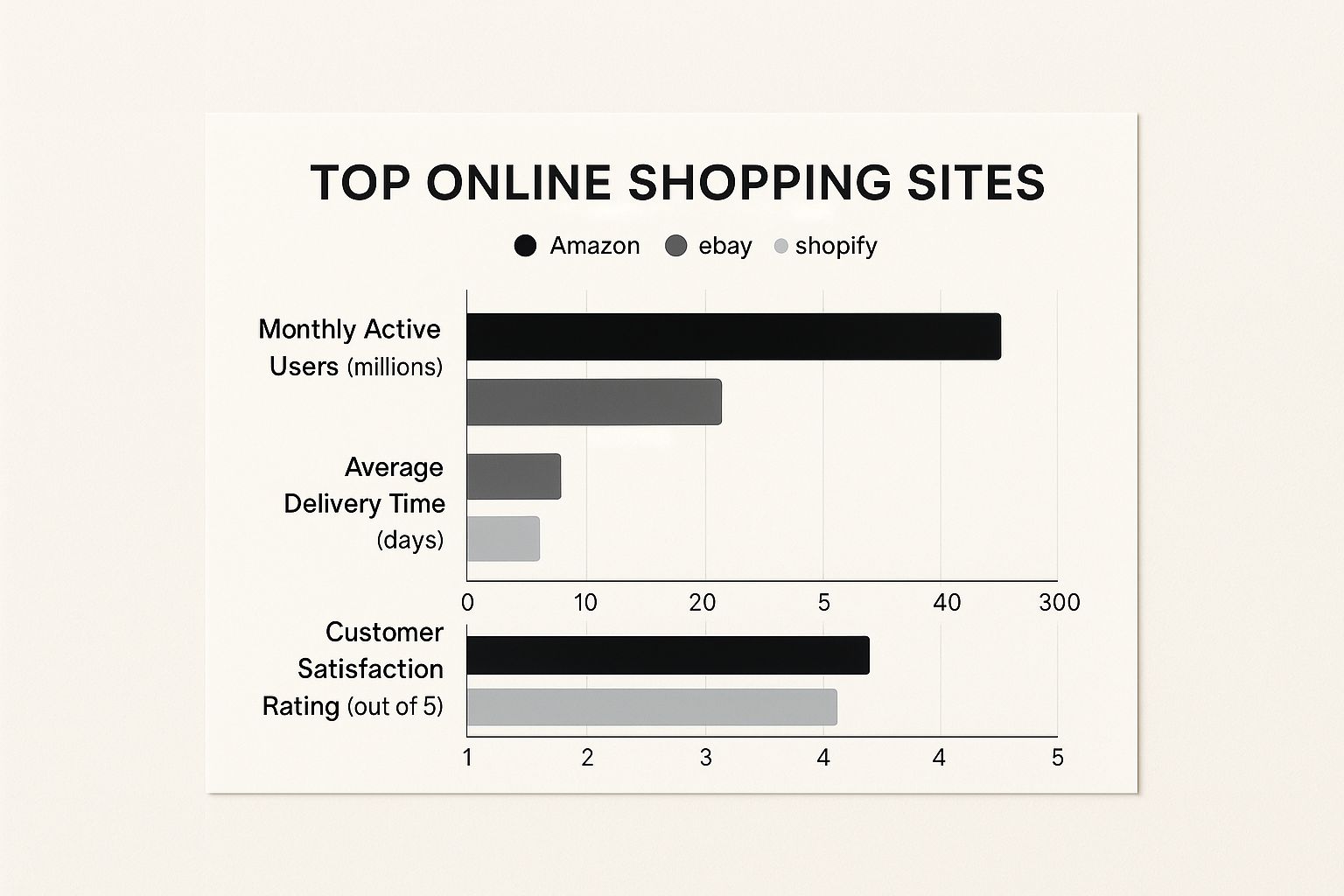Everyone knows the usual suspects when you're looking for the best online shopping sites. You hit up Amazon for its get-it-tomorrow speed and mind-boggling selection. You treasure-hunt on eBay for that one-of-a-kind find. Or you swing by Walmart's digital aisles for no-fuss, budget-friendly basics.
But the "best" site isn't a one-size-fits-all answer. Sometimes you need a platform that gets you—one that serves up curated experiences or hyper-personal recommendations instead of just an endless catalog.
Your Ultimate Guide to Smarter Online Shopping

Alright, let's settle this. Welcome to the main event, where we pit the giants of online retail against each other and a few specialized players, including the innovative newcomer, AMI Cart. The digital marketplace is a jungle, and it’s way too easy to get lost.
This guide is your machete. We’re hacking through the noise to compare what really makes a difference to your shopping experience. Forget the marketing fluff; we’re getting into the nitty-gritty of what makes a platform genuinely great for your specific needs, so you can click "buy" with total confidence.
What Really Makes an Online Store Great?
The platforms that consistently win our business have mastered a few critical things. It’s not always about being the rock-bottom cheapest. It’s about delivering a smooth, reliable, and maybe even enjoyable experience from start to finish.
The real champions nail these five areas:
- Vast Product Selection: You can find everything from AAA batteries to a rare 19th-century manuscript, all in one spot.
- Competitive Pricing and Deals: It’s not just about low prices, but also about smart deals, loyalty perks, and discounts that don’t make you jump through hoops.
- Fast and Reliable Shipping: No guessing games. They give you clear delivery dates, multiple options (hello, free shipping!), and tracking that actually works.
- Intuitive User Experience (UX): The site just works. It's clean, fast, and makes finding what you want—and things you didn't know you wanted—incredibly simple.
- Helpful Customer Service: When something goes wrong, you can reach a real human who fixes the problem quickly. That’s how you build trust.
Comparing the Top Online Shopping Contenders
Let's be real: different stores are built for different missions. One platform is your go-to for last-minute panic buys, while another is where you go to discover something new and exciting. To shake things up, we’re throwing our fictional competitor, AMI Cart, into the ring to show how its AI-first approach to personalization is changing the game.
| Feature | Amazon | eBay | Walmart | AMI Cart (Fictional) |
|---|---|---|---|---|
| Best For | Unbeatable speed and massive selection | Rare, vintage, and auction items | Everyday value and groceries | AI-driven personal recommendations |
| Shipping Strength | Prime next-day and same-day delivery | Varied (seller-dependent) | In-store pickup and local delivery | Optimized global shipping options |
| Pricing Model | Competitive with dynamic pricing | Auction-based and fixed-price listings | Consistently low everyday prices | Proactive price drop alerts |
| Unique Trait | A-to-z product ecosystem | Strong seller rating system | Seamless online-to-offline shopping | Curated, individualized storefront |
Navigating the Modern eCommerce Maze

Let's pull back the curtain for a moment. Online shopping has exploded from a niche convenience into a global force that’s completely reshaped how we buy… well, everything. For billions of us, it’s not just an alternative anymore; it's the default. To really get a handle on which platforms are the best online shopping sites, you first have to grasp the sheer scale of this digital marketplace.
This isn't just a collection of websites. It’s a massive ecosystem driven by powerful trends that influence everything from what’s in stock to how fast that package shows up at your door. Ever wonder why one retailer can master next-day delivery while another nails that perfectly curated, boutique feel? It all comes back to the staggering growth and the ever-changing habits of shoppers around the world.
The Mobile Shopping Takeover
The single biggest game-changer? We’re all shopping from the little screens in our pockets. The days of being chained to a desktop to place an order are ancient history. This massive migration to mobile has sent every online retailer scrambling to adapt or get left behind.
Mobile commerce—or m-commerce, if you want to get technical—isn't just a piece of the puzzle. It is the puzzle. A clunky app or a website that makes you pinch-and-zoom your way to frustration is an instant deal-breaker. The platforms that get it right are built with a mobile-first philosophy, prioritizing dead-simple navigation, one-tap checkout, and crystal-clear product pages.
The New Standard: If an online store doesn’t feel buttery-smooth on your phone, it’s already losing. The top players pour resources into their mobile experience because they know that’s where the action is.
This shift has also put digital wallets in the spotlight. Think Apple Pay, Google Pay, and PayPal. They’ve become the go-to for millions, completely erasing the tedious task of punching in credit card numbers. When over half of all online payments flow through these services, the platforms that integrate them seamlessly have a serious leg up.
Understanding the Global Scale
The numbers behind this boom are just wild. In 2025, global eCommerce sales are expected to hit a mind-boggling $7.4 trillion to $8.3 trillion. That’s a jaw-dropping growth of over 55% since 2021, powered by the 2.77 billion people who now regularly shop online.
What's fueling this? Mobile is the undisputed king, with over 70% of all online purchases now happening on smartphones. And it's all made frictionless by digital wallets, which are used in more than half of those transactions. If you're a data geek, you can discover more about digital commerce statistics and go down the rabbit hole.
This global scale has a direct impact on your shopping experience. It means:
- Endless Variety: You can buy just about anything from sellers anywhere on the planet.
- Logistical Puzzles: It’s why shipping times and costs can be all over the map.
- Fierce Competition: Retailers are in a constant battle for your business, which translates to better deals, more sales, and juicier perks for you.
As we start comparing the heavyweights of online retail, keep this bigger picture in mind. Their every move—their strengths, their weaknesses, their entire business model—is a reaction to these massive market forces. Getting a feel for the landscape is the first step to becoming a much smarter shopper.
Comparing the Titans of Online Retail
Alright, it's showtime. We're stepping into the ring with the undisputed heavyweights of online retail to see who really deserves your click. When you're on the hunt for the best online shopping sites, Amazon, eBay, and Walmart are the names that echo the loudest, but they’re all playing vastly different games.
Forget the flashy ads. We’re diving into the nitty-gritty of everyday shopping to see who lands the winning punch when it actually matters.
Need a last-minute birthday gift delivered by tomorrow? That’s a test of Amazon’s legendary Prime delivery versus Walmart’s slick in-store pickup. Hunting for a rare vintage camera? It's a showdown between eBay’s auction-house thrill and Amazon’s sprawling third-party marketplace. We're breaking it all down to reveal who wins.
The Speed and Convenience Showdown
In the battle for instant gratification, nobody throws a faster punch than Amazon. Its Prime membership has completely rewired our expectations for what "fast shipping" even means. If you need something—anything—in less than 48 hours, Amazon is almost always the champ by default.
But hold on. Walmart counters with a clever jab of its own. Its massive network of physical stores gives it a unique edge with same-day grocery delivery and curbside pickup for thousands of items. If you need party supplies for tonight, ordering online and swinging by your local Walmart can often beat even the quickest Amazon drone.
The Real Difference: Amazon is king of sheer delivery speed for a massive range of items shipped to your door. Walmart, on the other hand, nails immediate needs by blending its online and physical stores for ridiculously fast pickup.
This obsession with speed is a huge reason the United States has become the world’s second-largest eCommerce market, pulling in a staggering $1.16 trillion in 2023. Amazon leads this charge, raking in about $130.27 billion in annual online sales, with giants like Walmart contributing tens of billions more. You can get the full scoop on these online retail trends to see just how massive the market has become.
To see how these giants really stack up, this chart lays it all out—monthly active users, average delivery times, and what customers actually think of them.

The data speaks for itself. Amazon dominates web traffic, but you can see that delivery times and customer satisfaction are a tight race across the board.
The Battle for Unique and Niche Finds
Okay, but what if you're not just buying another phone charger? What if you're hunting for a first-edition book, a vintage band t-shirt, or a weirdly specific part for a ten-year-old appliance? This is where the fight shifts from speed to specialization, and eBay jumps into the ring with a totally different game plan.
eBay built its empire by being a global flea market—a treasure trove for the unique, the rare, and the pre-loved. Its auction-style listings and rock-solid seller rating system make it the go-to for collectors and serious bargain hunters. The thrill of the bid, of potentially snagging a one-of-a-kind item for a steal, is an experience Amazon and Walmart just can't touch.
- For the Collector: If you're looking for something with a story, eBay's user-driven marketplace is your playground.
- For the DIY Pro: Need a specific, out-of-production part for a project? An eBay seller probably has it.
- For the Deal Seeker: The auction format can lead to incredible finds if you’re patient and play your cards right.
Sure, Amazon’s third-party marketplace is huge, but it's mostly geared toward new products. You can find used stuff, but the platform isn't built for the thrill of the hunt. And Walmart? It’s not even in this weight class.
To bring this all home, let's look at how these platforms perform in situations you might actually find yourself in.
Retail Titan Showdown: Real-World Scenarios
A practical look at how the biggest online stores perform in common shopping situations, featuring our specialized contender, AMI Cart.
| Shopping Scenario | Amazon | eBay | Walmart | AMI Cart (Specialty) |
|---|---|---|---|---|
| "I need a popular new video game by tomorrow" | Winner. Prime next-day or same-day delivery is unbeatable for new, in-demand items. | Slower. Shipping depends on individual sellers, so it's not ideal for urgent needs. | Viable. Order online for same-day in-store pickup if it's in stock locally. | Not its focus. Geared more toward unique or personalized items, not mass-market speed. |
| "I'm searching for a rare 1980s comic book" | Unlikely. Marketplace is mostly new items; finding collectibles is a long shot. | Winner. The best place to find vintage, rare, and collectible items from sellers worldwide. | Not a chance. Focuses exclusively on new, mainstream consumer goods. | Could surprise you. Might curate specialty sellers who deal in vintage pop culture. |
| "I need groceries and household supplies for dinner tonight" | Possible with Fresh/Whole Foods, but delivery windows can be limited. | No. Not a platform for fresh groceries or everyday consumables. | Winner. Order online and use curbside pickup within hours. The perfect blend of digital and physical. | Not applicable. Its model is built around discovering products, not daily essentials. |
| "I want a unique, handcrafted gift for a friend" | Some options through Amazon Handmade, but can be hard to find among mass-produced goods. | Good option. Many independent sellers and artisans list unique items. | Very limited. Primarily stocks mass-produced items from major brands. | Winner. Its entire purpose is to learn your tastes and surface unique, personalized items. |
As you can see, the "best" store completely depends on what you're trying to accomplish. Each one has a clear lane where it dominates.
The Personalization Contender: AMI Cart
While the titans duke it out over speed and selection, a new challenger is playing an entirely different game: hyper-personalization. Let's talk about our conceptual contender, AMI Cart. Instead of trying to be everything to everyone, a platform like AMI Cart uses AI to learn your specific tastes, habits, and needs.
Imagine a storefront that rearranges itself just for you. It knows you’re a tech enthusiast who loves minimalist design or a fashion lover who gravitates toward sustainable brands. It doesn't just show you what you've searched for; it proactively surfaces products you'll genuinely love but haven't even discovered yet.
This is where online shopping is headed. While Amazon recommends stuff based on what you bought, AMI Cart aims to predict what you'll want, creating a curated boutique experience inside a massive catalog. It's a shift from a search-first model to a discovery-first one, making the hunt for the perfect item feel less like a chore and more like an adventure.
Finding Your Tribe in a Niche Marketplace

While the behemoths of online retail are busy duking it out for your everyday purchases with promises of lightning-fast shipping and endless aisles, there's a whole other universe of shopping happening just out of the spotlight. Welcome to the world of niche marketplaces—specialty shops built around passions, hobbies, and distinct lifestyles. Forget the mind-numbing scroll; these are places for enthusiasts who know exactly what they're after.
These platforms aren't trying to be the jack-of-all-trades. They succeed by building a genuine community for people who are all-in on a specific interest, whether that's handmade leather goods, high-end PC components, or the latest streetwear drops. It's proof that sometimes, the best online shopping sites aren't the biggest ones, but the ones that truly get you.
The Magic of Curation and Community
Niche marketplaces win because they understand their audience on a ridiculously deep level. They get the subtle differences between a mechanical keyboard with clicky Cherry MX Blue switches and one with smooth Reds, or why a knitter might need a specific merino wool from a particular region. That insider knowledge is baked right into the shopping experience.
Just look at Etsy. It’s not simply a website to buy stuff; it’s a sprawling global craft fair where you can chat directly with the person who made your wallet. Its entire business model is built on uniqueness and a human touch—something you'll never find in a big-box digital store. In the same way, Newegg became the go-to for PC builders by offering an insane selection of parts and reviews from people who actually know their tech.
A great niche site doesn't just sell you something; it validates your passion. It’s where the community makes the shopping better, offering insights and a sense of belonging that a generalist retailer can't possibly replicate.
These platforms often have incredibly specific search filters, community forums, and expert guides that help you track down exactly what you need, no matter how obscure. Their whole purpose is to cut through the digital noise and deliver something relevant and genuinely satisfying.
A Look at the Top Niche Players
Let's break down how a few of these specialists cater to their dedicated fans. Each one creates a unique bubble tailored for a specific kind of shopper.
-
For the Creative Soul (Etsy): This is the undisputed champion for handcrafted goods, one-of-a-kind vintage finds, and unique art supplies. Its magic lies in the direct connection between buyers and sellers and the sheer creativity on display. Finding a gift here feels like a treasure hunt.
-
For the PC Builder (Newegg): A digital paradise for anyone building a computer from scratch or just upgrading their graphics card. Newegg is packed with detailed specs, a brilliant component compatibility checker, and a legion of tech-savvy reviewers, making it an essential resource for complicated tech buys.
-
For the Trendsetter (ASOS): This fashion giant is aimed squarely at young adults, with a massive, constantly refreshing catalog of clothes and accessories from hundreds of brands. Its powerful filters for style, size, and fit, paired with a slick mobile app, make it the first stop for hunting down the latest looks.
These sites prove that by zeroing in on a specific audience, you create a far more rewarding journey. To see how these dynamics play out locally, our guide to the online marketplace in Australia offers some fantastic regional insights.
What if Your Niche Is… You?
Okay, but what if you don't fit into a single neat box? What if you're a tech-head who also loves sustainable fashion and collects vintage movie posters? This is where the idea of a "personalized niche" comes into its own, and it's powered by some seriously smart tech.
This is exactly the problem platforms like AMI Cart are built to solve. Instead of trying to pigeonhole you, AMI Cart's AI gets to know your unique blend of interests and tastes over time. It essentially creates a custom, curated storefront just for you, giving you the variety of a massive store but with the laser-focused feel of a specialist.
Picture a shopping feed that serves you the newest gadget, followed by an eco-friendly backpack from a cool indie brand, and then a piece of art that just screams you. It’s like having a personal shopper who understands every facet of your personality. This approach creates a "niche of one," delivering a truly bespoke experience that mixes discovery with deep personalization—and it just might be the next evolution in finding the best online shopping sites for your own unique needs.
Unlocking Pro-Level Savings and Deals
Scoring an incredible deal feels like hitting the jackpot, right? The most seasoned shoppers have a whole playbook for making that feeling a regular occurrence. This isn't just about clipping a coupon here and there. We're talking about the real strategies that take you from a casual buyer to a bona fide savings guru.
It’s a bit of a cat-and-mouse game between you and the retailers, but with the right moves, you can almost always walk away the winner. From clever browser extensions that do the work for you to mastering the retail calendar, let’s break down how to get the most bang for your buck on the best online shopping sites.
Your Automated Deal-Finding Arsenal
Let’s be honest, who has time to scour the internet for coupon codes anymore? The most powerful weapon in a modern shopper’s toolkit is automation. Browser extensions that quietly hunt for deals in the background are non-negotiable these days. They turn the tedious chore of finding a discount into a satisfying, automatic win right at checkout.
The two heavyweights in this arena are Honey and Rakuten, but they play the game differently.
- Honey (now owned by PayPal): Think of Honey as your personal coupon detective. It springs into action at checkout, rapidly testing every discount code it can find for that store. In seconds, it applies the one that saves you the most money. It’s the ultimate set-it-and-forget-it tool for that instant thrill of a lower price.
- Rakuten: This one is all about cashback. You start your shopping trip by clicking through Rakuten's site or app. They get a commission from the store for sending you their way, and they split that commission with you. The savings aren't instant—they build up and get paid out every quarter—but it can add up to some serious cash.
So, which one to use? The pro move is to use both. Let Honey slash the price with an immediate discount code, then collect your Rakuten cashback on the new, lower total. It's a one-two punch that can dramatically shrink your final bill.
The magic of these tools is that they find savings you'd probably never discover on your own. Once you start using them, you'll wonder how you ever paid full price for anything.
Timing is Everything: The Retail Calendar
Beyond the tech, the single biggest factor in landing a massive discount is simply when you buy. Retailers run on a surprisingly predictable schedule, and knowing the rhythm of the retail year is just as crucial as knowing where to shop.
Think of major sales events as your Super Bowl. Black Friday and Cyber Monday are the obvious titans, but don't overlook others. Amazon's Prime Day has become so huge that it forces competitors like Walmart and Target to launch their own massive sales just to keep up. Planning your big-ticket purchases around these key dates is a surefire way to save.
Here’s a quick cheat sheet for your strategic calendar:
- January: The famous "White Sales" make this the perfect time to snag deals on bedding, towels, and home goods as stores clear out last year's inventory.
- July: Prime Day and all the competing sales mean deep discounts on electronics, smart home gadgets, and Amazon's own devices.
- Late Summer (Aug/Sept): Back-to-school sales aren't just for students. It's a fantastic time to find deals on laptops, office supplies, and even clothes.
- November: The Black Friday/Cyber Monday marathon is the main event. You'll find the steepest discounts of the year on pretty much everything, especially electronics, toys, and gifts.
The Loyalty Program Gambit
Retailer loyalty programs are designed to keep you in their ecosystem, but not all are created equal. Some, like Amazon Prime, give you obvious, immediate value with perks like free shipping. Others are based on a points system that can feel like a painfully slow grind toward a tiny reward.
The secret is to figure out what they're really worth. Does the program offer perks you'll actually use on a regular basis, or is it just a clever way for them to collect your shopping data? Always do the math. If you have to spend $500 just to earn a $10 coupon, it’s probably not worth your exclusive loyalty.
But what if finding deals could be completely effortless? This is where a platform like AMI Cart flips the entire script with its 'DealRadar' system. Instead of you having to hunt for deals, it brings the deals to you. You just add an item to your wishlist, and DealRadar gets to work, monitoring its price across the web. The second it drops, you get an alert. This transforms deal-finding from an active, time-consuming search into a completely passive system, guaranteeing you never miss the perfect moment to buy. It’s a smarter, more modern way to save.
So, Which Online Store Is Right for You?
After sizing up the heavyweights and the niche specialists, it’s pretty obvious there's no single "best" online shopping site. The real win is finding the one that just clicks with what you need, right when you need it. Forget about lifelong loyalty to one store; the smart move is to have a go-to list for every kind of shopping mission.
Think of it like building a championship team. You wouldn’t put your star quarterback on the defensive line. In the same way, trying to make one online store do everything is a losing game when others are built for a specific purpose. It all boils down to what you're after at that moment—blazing-fast delivery, a killer deal, a one-of-a-kind find, or an experience that feels like it was made just for you.
Your Personal Shopping Playbook
Let's cut through the noise and get straight to it. Here’s a simple guide to help you pick the right player for the right job.
-
When you need it yesterday: Amazon Prime is the undisputed champ. Nothing beats its logistics network for getting a massive range of everyday stuff to your door at ludicrous speed. If the clock is ticking, this is your first and only stop.
-
When you’re on the hunt for treasure: Dive into eBay and Etsy. These are the digital treasure chests of the internet, filled with unique, vintage, and handmade goods. They offer the thrill of the hunt and the chance to own something with a story—something no big-box store can ever replicate.
-
When you’re all about budget-friendly basics: Walmart is the king of value. For your weekly grocery run, household staples, and consistently low prices, its mix of online shopping and in-store pickup is a powerful, money-saving combo for families.
The Modern, Curated Choice
But what if you're looking for something a bit more... refined? For shoppers who want a smarter, more personal experience, the future is in platforms like AMI Cart. It takes a different approach, using tech not just to move products, but to help you discover things you'll actually fall in love with.
AMI Cart learns your style and crafts a shopping journey that feels less like wandering a giant, impersonal warehouse and more like exploring a high-end boutique. It's perfect for anyone who values discovery over scrolling through endless, overwhelming catalogs.
This forward-thinking model really shines when combined with flexible payment options. Offering a variety of ways to pay—from digital wallets to good old-fashioned cards—is the signature of a truly modern, customer-first platform. To get the full scoop on your choices, check out our guide on payment methods for online shopping.
In the end, the best online shop is the one that solves your problem with zero hassle. By knowing the strengths of each major player—and innovative newcomers like AMI Cart—you can shop like a pro, always confident you’re clicking in the right place at the right time.
Got Questions About Online Shopping? We've Got Answers.
Jumping into the world of online shopping can feel a little overwhelming at first. There are a million stores, endless deals, and you’ve probably got a few questions. Don’t worry, we’ve heard them all. Let’s clear up some of the common concerns so you can shop like you’ve been doing it for years.
Think of this as your cheat sheet. We'll cover everything from keeping your payment details locked down to becoming a master of the easy return. It’s not just about finding the best online shopping sites; it’s about owning the entire experience.
Is It Actually Safe to Shop Online?
Yes, it absolutely is—as long as you’re a little savvy. The truth is, the vast majority of online purchases go off without a hitch. Big-name retailers pour a ton of money into top-notch security because if you don't trust them, they don't have a business.
But it’s a two-way street. Your own online habits are your best defense against the bad guys. A few smart moves can make all the difference.
- Look for the Lock: Always check for "https://" and that little padlock symbol in your browser's address bar. That’s your sign that the connection is secure and encrypted.
- Create Fort Knox Passwords: Never, ever reuse the same password across different sites. I know it's a pain, but a good password manager makes it easy to create and store unique, strong passwords for every account.
- If It Looks Fishy, It Is: That brand-new iPhone for $50? It’s a scam. Your common sense is your best friend here, so trust it.
Want to really shore up your defenses? We put together a whole guide on tips for safe online shopping that’s worth reading before you check out.
What’s the Secret to Painless Returns?
Ugh, returns. They can be a real drag, but the best online stores have made it a surprisingly simple process. The trick is to scope out the return policy before you even add something to your cart. Look for things like free return shipping, which is a game-changer.
You know you've found a great store when they include a pre-paid return label right in the box. Amazon is famous for this, but other retailers like Zappos and ASOS have built their reputations on making returns ridiculously easy for their customers.
And a pro tip: hang onto the original box and packaging for a few days. If you do need to send something back, having it on hand makes life so much easier.
How Do I Make Sure I’m Getting the Best Deal?
Gone are the days of manually opening twenty tabs to compare prices. We have technology for that now! Browser extensions and price comparison sites are your new best friends. They do all the legwork automatically, so you can be confident you aren't overpaying.
Timing is also a huge factor. If you can hold out for major sales events like Black Friday, Cyber Monday, or Amazon Prime Day, you'll see the deepest discounts all year. Another sneaky good trick? Sign up for email newsletters from brands you love. They often send out exclusive discount codes and early-bird sale alerts just for their subscribers.
Feeling more confident? Great! Now it's time to put that knowledge into action. At AMI Cart, we've built a shopping experience that's not only secure and easy but genuinely fun. You'll find incredible deals, curated collections, and pretty much everything else you're looking for. Start exploring today!




